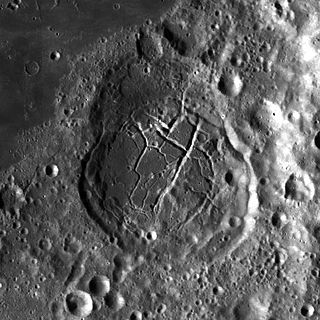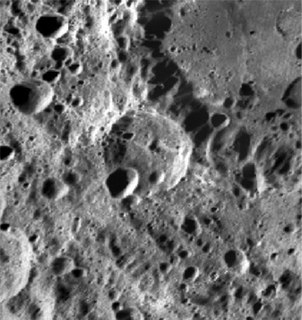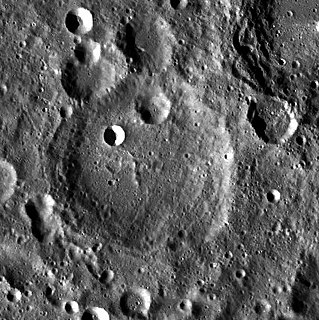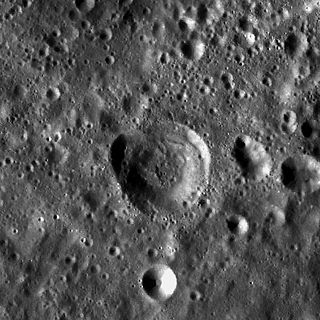
Appleton is a heavily eroded lunar impact crater that lies in the northern hemisphere on the far side of the Moon. To the northwest are the craters Von Neumann and Campbel. The smaller Golovin lies to the northeast, while further to the southwest is the Mare Moscoviense.

Baade is a lunar impact crater that is located near the southwest limb of the Moon on the near side, to the southwest of the enormous Mare Orientale impact basin. The area to the east of this crater forms the junction between the 280-km-long Vallis Bouvard to the north and the narrower, 160-km-long Vallis Baade to the south-southeast. Both valleys radiate away from the impact basin to the north.

Boss is a lunar impact crater that is located along the northeast rim of the Moon's near side. Due to its location, the crater is viewed from the side by observers on the Earth, and its visibility is subject to libration effects.

Bel'kovich is a large lunar impact crater of the form termed a walled plain. The formation has been heavily eroded by a history of subsequent impacts, leaving it reshaped, worn, and the features softened and rounded. Bel'kovich is located along the northeastern limb of the Moon, and so its visibility is subject to libration effects. From the Earth this crater is viewed from the side, making it difficult to view it in detail.

D'Arrest is a lunar impact crater that is located in the lava-flooded region to the west of the Mare Tranquillitatis. It is named after the German astronomer Heinrich Louis d'Arrest. It lies to the southeast of the crater Agrippa and northwest of Delambre. Just to the northeast are the small, bowl-shaped craters De Morgan and Cayley.

Komarov is a lunar impact crater that lies across the southeastern edge of Mare Moscoviense, on the northern hemisphere of the far side of the Moon. It is a complex feature with an irregular appearance.

Belyaev is a lunar impact crater that is attached to the outer edge of the Mare Moscoviense, on the far side of the Moon. It is a worn formation with a small crater pair overlaying the southern rim, and several smaller craters across the relatively irregular interior.

Blackett is a lunar impact crater that lies on the far side of the Moon, behind the southwest limb. It lies beyond the southeast outer ring of the immense Mare Orientale basin. The formation of that major feature has left Blackett deeply marked with ridge features trending from the northwest. Much of the crater has been shaped by the ejecta from Mare Orientale, particularly along the western half of the crater.

Casatus is a lunar impact crater that is located near the southern limb of the Moon. The north-northeast rim of the crater overlies a portion of the slightly larger crater Klaproth. Along the western rim, Casatus A intrudes somewhat into the interior, producing an inward-bowing rim. To the southeast of Casatus is Newton.

Delaunay is a lunar impact crater. It was named after French astronomer Charles-Eugène Delaunay. The craters La Caille to the southwest and Faye to the northeast border on the outer rim of Delaunay. Further to the northwest is the prominent Arzachel.

Donner is a lunar impact crater on the far side of the Moon. It is located just to the northeast of the Mare Australe, behind the southeastern limb of the Moon. During favorable librations this part of the lunar surface can be brought into view of the Earth, but the site is viewed from the edge and so not much detail can be seen.

Feoktistov is a small lunar impact crater on the far side of the Moon. It lies in the northern hemisphere, to the northwest of the Mare Moscoviense. This crater has a small outward extension along the northern side, giving it the appearance of two overlapping craters that have merged. There are slight indentations of the rim along the east and northwest sides. The rim is otherwise rounded and not significantly worn. Apart from an irregular strip in the northeast, the floor is relatively featureless.

Fridman is the remains of a lunar impact crater on the far side of the Moon. It lies due south of the huge walled plain Hertzsprung, and is attached to the northeastern rim of the crater Ioffe.

Gerasimovich is a lunar impact crater on the far side of the Moon. It lies beyond the western limb, to the west-northwest of the immense Mare Orientale impact basin. The outer blanket of ejecta from this impact reaches nearly to the rim of Gerasimovich. Nearby craters of note include Houzeau to the north and the smaller Ellerman to the southeast.

Kohlschütter is a lunar impact crater that cannot be viewed directly from the Earth as it lies on the Moon's far side. It is located a couple of hundred kilometers to the southeast of the Mare Moscoviense, and due south of the smaller crater Nagaoka. It is a relatively isolated formation surrounded by a multitude of smaller impacts typical of the battered far side.

Kurchatov is a lunar impact crater that is located on the Moon's far side. It is just to the southwest of the crater Wiener, and farther to the southeast of Bridgman. A couple of crater diameters to the south of Kurchatov is the northern edge of the Mare Moscoviense.

Leonov is a small lunar impact crater that lies to the south of Mare Moscoviense, one of the few maria on the far side of the Moon. This crater has a heart-shaped outline, due to an outward bulge along the northwest side. The rim of Leonov is worn, and several tiny craterlets lie along the edge. The inner walls and interior floor are relatively featureless.

Nagaoka is a lunar impact crater that lies to the southeast of the Mare Moscoviense, on the far side of the Moon. To the east of Nagaoka is the somewhat larger Konstantinov.

Tereshkova is a relatively small lunar impact crater on the far side of the Moon. It is located along the western perimeter of the Mare Moscoviense, and to the southeast of the crater Feoktistov.

Tikhomorov is the heavily eroded remains of a lunar impact crater on the Moon's far side. It lies to the northeast of the smaller crater Konstantinov, and to the southwest of Trumpler. Farther to the west-northwest is Mare Moscoviense, one of the few maria on the far side of the Moon.


























